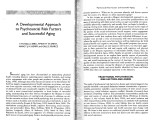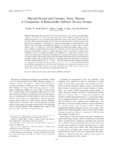Filters: School Or College: "College of Social & Behavioral Science" Department: "Psychology" Collection: "ir_uspace"
| Creator | Title | Description | Subject | Date | ||
|---|---|---|---|---|---|---|
| 51 |
 |
Berg, Cynthia A. | Commentary: lessons from a life-span perspective to adolescent decision making | The chapters in Part II address important aspects of adolescent decision making that have received little attention in the literature to date. Decision making is examined as adolescents make decisions regarding their afterschool activities (Gauvain & Perez, chap. 7), make decisions utilizing democra... | Adolescents; Adolescent decision making | 2005 |
| 52 |
 |
Malloy, Thomas E.; Jensen, Gary C. | Emergence of dynamic form through phase relations in dynamic systems | Gregory Bateson construes mental process as the flow and transforms of differences in a system. Stuart Kauffman uses NK Boolean systems to model the emergence of order in biological evolution. Because the Boolean base (0, 1) maps to Bateson's idea of difference, we simulate Bateson's epistemology wi... | Systems; Psychology; Models | 2005-10-24 |
| 53 |
 |
Diamond, Lisa | Intimate same-sex relationshps of sexual minorities | This chapter provides an overview of current research on same-sex intimate relationships, emphasizing the most central and well-researched domains: relationship initiation, maintenance, satisfaction, and dissolution, gender-related dynamics, sexuality and sexual exclusivity, and violence and ab... | Same-sex relationships; Partnering; Sexual minorities; Domestic relationships | 2006 |
| 54 |
 |
Fogel, Alan Dale | Hikikomori in Japanese youth: some possible pathways for alleviating this problem from the perspective of dynamic systems theory | In this paper, we will discuss the problem of hikikomori, in which an individual remains at home, typically isolated in the bedroom, with limited contact to the outside world. Hikikomori has been discussed primarily from a psychological perspective in Japan. In this paper, we take dynamic systems pe... | Social withdrawal; Dynamic systems theory | 2006 |
| 55 |
 |
Fogel, Alan Dale | Change processes in relationships: a relational-historical research approach | This work was supported by grants to Alan Fogel from the National Institute of Health (R01 HD21036), the National Science Foundation (BNS9006756) and the National Institute of Mental Health (R01MH48680), and by a grant to Andrea Garvey from the National Science Foundation of Brazil (CNPq). We grate... | 2006 | |
| 56 |
 |
Diamond, Lisa | Careful what you ask for: reconsidering feminist epistemology and autobiographical narrative in research on sexual identity development | Feminist theory has had an undoubtable but inconsistent influence on developmental psychology. Although feminist perspectives have productively challenged developmental models centered on male experiences (Gilligan 1982) and have called attention to socialization practices that reproduce systemati... | Feminism; Epistemology; Autobiography | 2006 |
| 57 |
 |
Malloy, Thomas E. | Logic of logic and the logic of dreams. | For Bateson explanation is the mapping of description onto tautology. "An explanation has to provide something more than a description provides, and in the end, an explanation appeals to a tautology, which as I have defined it, is a body of propositions so linked together that the links between the ... | Science; Psychology; Dreams | 2006-02 |
| 58 |
 |
Malloy, Thomas E.; Jensen, Gary C. | Mapping Bateson's Epistemology to Boolean Dynamic System: 1. The Emergence of Dynamic Form & 2. Hierarchies Form. | Gregory Bateson (e.g., 2002, p. 85ff; 2000, p. 457-460) construed knowledge to be the propogation of "difference" in a complex network, noting (2000 p. 460) that "the transform of difference travelling in a circuit is an elementary idea." The idea of difference is coded as 0 and 1 in Boolean system... | Network; Complex; Psychology; Mind; Nature | 2006-07-10 |
| 59 |
 |
Malloy, Thomas E. | Prerequisites to Batesonian Epistemology | The Logic of Metaphor maps sets of relations from one realm to another realm generating tautologies in the logic of logic. | Psychology; Logic; Reason; Mind; Nature | 2006-08-05 |
| 60 |
 |
Malloy, Thomas E.; Jensen, Gary C. | Mapping Gregory Bateson's epistemology to nonlinear dynamic systems theory: dynamic form and hierarchies of knowledge | Gregory Bateson construes mental process as the flow and transform of differences in a system whether the system be a single human or a complex ecology. Stuart Kauffman uses NK Boolean systems to model the self-organization of order in biological evolution. Because the Boolean base (0, 1) maps to Ba... | Network; Complex; Psychology; Mind; Nature | 2006-10-23 |
| 61 |
 |
Diamond, Lisa | Physiological measures | Historically, psychophysiological measures have made an invaluable contribution to personality psychology. Questions regarding interindividual differences and intraindividual changes in emotion, cognition, motivation, arousal, and attention are core topics within personality psychology, and the... | Personality; Psychology; Physiology | 2007 |
| 62 |
 |
Florsheim, Paul W. | Hostile personality traits and coronary artery calcification in middle-aged and older married couples: different effects for self-reports versus spouse ratings | To examine the association between hostile personality traits and coronary artery disease (CAD) and the role of aspects of hostility, method of assessment, and age as influences on its magnitude, as prior studies of hostility and coronary artery calcification (CAC) have produced conflicting findings... | hostility; anger; antagonism; agreeableness; coronary artery calcification; coronary artery disease | 2007 |
| 63 |
 |
Berg, Cynthia A.; Smith, Timothy W. | Developmental approach to psychosocial risk factors and successful aging | Successful aging has been characterized as maintaining physical health (avoiding disease), sustaining good cognitive function, and having active engagement with other people and productive activities (Rowe 8c Kahn, 1998). Although these three factors are known to be interrelated, the field has large... | 2007 | |
| 64 |
 |
Berg, Cynthia A.; Smith, Timothy W.; Uchino, Bert N.; Hopkins, Paul N.; Yoon, Hyo-Chun | Hostile personality traits and coronary artery calcification in middle-aged and older married couples: different effects for self-reports versus spouse ratings | Objective: To examine the association between hostile personality traits and coronary artery disease (CAD) and the role of aspects of hostility, method of assessment, and age as influences on its magnitude, as prior studies of hostility and coronary artery calcification (CAC) have produced conflicti... | 2007-06-01 | |
| 65 |
 |
Fogel, Alan Dale | Current problems of Japanese youth: some possible pathways for alleviating these problems from the perspective of dynamic systems theory | Yoshiko wouldn't reveal her son's name, because of fears that her neighbors in a suburb of Tokyo might find out. Three years ago, a classmate taunted her seventeen-year-old son with anonymous hate letters and abusive graffiti about him in the schoolyard. After that, he went into the family's kitche... | 2008 | |
| 66 |
 |
Fogel, Alan Dale | Human development in the twenty-first century: visionary ideas from systems scientists | The dynamic systems approach is an emerging interdisciplinary set of principles used by a diverse collection of scientists to help understand the complex world in which we live. The main insight that unites these scientists, despite wide differences in methods and concepts, is a focus on connection... | 2008 | |
| 67 |
 |
Werner, Carol M.; Brown, Barbara B. | Using accelerometer feedback to identify walking destinations, activity overestimates, and stealth exercise in obese and nonobese individuals | Accelerometer output feedback might enable assessment of recall biases for moderate bouts by obese and nonobese individuals; accelerometry might also help residents recall destinations for moderate-intensity walking bouts. Methods: Adult residents' 1-week accelerometer-measured physical activity and... | Physical activity assessment; METs; Community-based research; Obese | 2008 |
| 68 |
 |
Fogel, Alan Dale | Relationships that support human development | When Susan was one-and-one-half years old, she had been playing the "lion game" with her mother for the past few months. With a lion puppet on her hand, Susan's mother made the lion roar, tickle, bite, and tease Susan, who seemed delighted to be aroused and frightened. Susan and her mother first co... | 2008 | |
| 69 |
 |
Fogel, Alan Dale | Dynamic systems approach to the life sciences | Each of the chapters in this book points to expanding our understanding of the multiple and complex relationships that surround development through the lifespan. In this chapter, we as the organizing committee of the Council for Human Development give a brief description and overview of the science ... | Dynamic systems approach | 2008 |
| 70 |
 |
Drews, Frank; Westenskow, Dwayne R.; Pace, Nathan L.; Ogden, L. Lazarre; Strayer, David Lee | Part task and variable priority training in first-year anesthesia resident education: a combined didactic and simulation-based approach to improve management of adverse airway and respiratory events | Background: Part task training (PTT) focuses on dividing complex tasks into components followed by intensive concentrated training on individual components. Variable priority training (VPT) focuses on optimal distribution of attention when performing multiple tasks simultaneously with the goal of f... | Part task training; Variable priority training; PTT; VPT; Anesthesia residents | 2008 |
| 71 |
 |
Kesner, Raymond P. | The role of GABA-ergic interneurons in CA1 and dentate gyrus for sequence learning | The hippocampus (HPP) is widely accepted as a structure that supports spatial memory. Current interest is focused on temporal processing for sequences of events. It has been demonstrated that HPP lesions disrupt acquisition of a spatial temporal sequence in an 8-arm maze (DeCoteau & Kesner, 2000).... | Hippocampus, learning, memory, interneuron, CA1, dentate gyrus, sequence | 2010 |
| 72 |
 |
Smith, Timothy W. | Relative status, partner dominance, depression, & self-rated health | 2011 | ||
| 73 |
 |
Berg, Cynthia A. | An interpersonal analysis of subjective social status and psychosocial risk | Subjective social status (SSS) predicts health independently of traditional measures of socio-economic status (SES; Adler et al., 2008; Cohen et al., 2008). Although interpersonal variables are known to be related to both SES and health (Gallo, Smith, & Cox, 2006) and might contribute to their assoc... | 2011-01-01 | |
| 74 |
 |
Smith, Timothy W. | Marital discord and coronary artery disease: a comparison of behaviorally defined discrete groups | Objective: Marital difficulties can confer risk of coronary heart disease, as in a study of outwardly healthy couples (T. W. Smith et al., 2011) where behavioral ratings of low affiliation and high control during marital disagreements were associated with asymptomatic coronary artery disease (CAD). ... | 2012-01-01 | |
| 75 |
 |
Sansone, Carol | How students socially evaluate interest: peer responsiveness influences evaluation and maintenance of interest | Social influences (e.g., by teachers, parents and peers) on students' experience of interest are typically described in terms of affecting students' initial choice of and/or completion of specific educational activities. When considered within the framework of the Self-Regulation of Motivation (SRM)... | 2012-01-01 |
